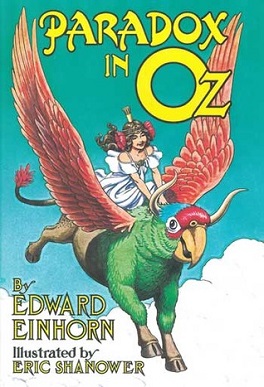Paradox in Oz facts for kids
 |
|
| Author | Edward Einhorn |
|---|---|
| Illustrator | Eric Shanower |
| Cover artist | Eric Shanower |
| Country | United States |
| Language | English |
| Series | The Oz Books |
| Genre | Fantasy |
| Publisher | Hungry Tiger Press |
|
Publication date
|
1999 |
| Media type | Print (Hardcover) |
| Pages | 237 |
| ISBN | 1-929527-01-2 |
| OCLC | 44424711 |
| LC Class | PZ7.E34445 Par 1999 |
Paradox in Oz is an exciting fantasy novel from 1999. It was written by Edward Einhorn. This book is part of the famous Oz series. These stories are about the magical Land of Oz, first created by L. Frank Baum. Many other authors have also written Oz books.
Contents
About the Book
Paradox in Oz was published by Hungry Tiger Press. It features wonderful pictures by Eric Shanower. This was Edward Einhorn's first novel. It was also his first book set in the Land of Oz. The book came out in 1999. This was 100 years after the first Oz book, The Wonderful Wizard of Oz. Many people loved Paradox in Oz when it was first released. They also praised Shanower's illustrations. One review called it a "gorgeous book."
What Kind of Story Is It?
Paradox in Oz is a fantasy story. It keeps the happy, perfect feeling of Baum's original Oz novels. But it also looks at some darker ideas. It creates a different, less perfect version of Oz. This is called the Obsidian City. It is the opposite of the bright Emerald City.
This book also uses ideas from science fiction. The main one is time travel. Even L. Frank Baum's original Oz stories had some science fiction ideas. He wrote about robots and advanced cities. Critics have noted that Oz is different from other fantasy worlds. It often includes new technology.
What Happens in the Story?
The story begins with people in Oz getting old. Omby Amby finds a white hair. Other citizens get wrinkles and back pain. Princess Ozma and her helpers realize something is wrong. The magic spell that kept everyone young has stopped working.
Ozma and Glinda look in the Great Book of Records. They find clues about a "Man Who Lives Backwards." This person is actually in Glinda's palace. But he is a baby right now. So he cannot help them understand the problem.
While trying to solve the mystery, Ozma and Glinda meet a strange creature. It is called a Parrot-Ox. This creature is half parrot and half ox. It has colorful feathers and hooved feet. Its name is Tempus. Parrot-Oxes are usually invisible. They can only do things that seem impossible.
Ozma rides Tempus back in time. She goes to meet King Oz, who ruled before her. She finds him near the Forbidden Fountain. Ozma accidentally changes the past. This makes Oz an evil place. A mean Wizard rules from the Obsidian City. This city is a dark copy of the Emerald City.
Ozma's friends are also changed. The beautiful Glinda is old and tired. The Tin Woodman is now a human. He is a cruel headsman named Nick Chopper.
To fix things, Ozma travels into the past many times. Soon, there are many Ozmas from different times in the woods. Ozma must face her own past self, Tip. She also travels to Absurd City. There, she hopes to find the Man Who Lives Backwards. Ozma faces many confusing situations. She meets many Parrot-Oxes. Finally, she must restore the Oz she knows and loves.
Hidden Oz Clues
Fans of Oz books will find many small clues in Einhorn's story. For example, Tempus talks about things that "never happened." He mentions "when East used to be West and West used to be East." This refers to a famous mistake in the Oz books.
In the first Oz book, The Wonderful Wizard of Oz, the Munchkin Country is in the East. Dorothy's house lands there. It kills the Wicked Witch of the East. But in later books, maps show Munchkin Country in the West.
In the Obsidian City, the evil version of Omby Amby is called Wantowin Battles. This name was first used by Ruth Plumly Thompson. It appeared in her book Ozoplaning with the Wizard of Oz (1939).
The evil Wizard in the story mentions the 1939 movie. He changes a line from the movie. He says he is "a very bad man, but I am a very good wizard." Then he casts a wicked spell.
The Illustrations
Eric Shanower created the black-and-white pictures for Paradox in Oz. His drawings have a rich, romantic style. He has used this style for many Oz books since 1986. For this book, Shanower also added new elements. He included parts of pop art and op art. He also used ideas from the artist M. C. Escher.

